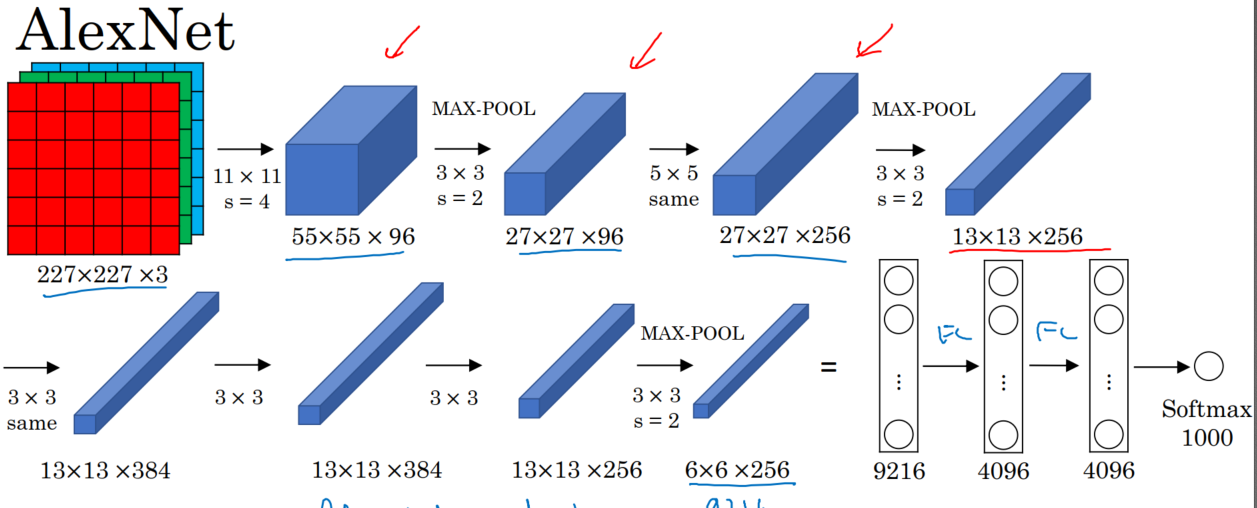一、AlexNet:共8层:5个卷积层(卷积+池化)、3个全连接层,输出到softmax层,产生分类。
论文中lrn层推荐的参数:depth_radius = 4,bias = 1.0 , alpha = 0.001 / 9.0 , beta = 0.75
lrn现在仅在AlexNet中使用,主要是别的卷积神经网络模型效果不明显。而LRN在AlexNet中会让前向和后向速度下降,(下降1/3)。
【训练时耗时是预测的3倍】

代码:
#加载数据 import tensorflow as tf from tensorflow.examples.tutorials.mnist import input_data mnist = input_data.read_data_sets("MNIST_data/",one_hot = True) #定义卷积操作 def conv2d(name , input_x , w , b , stride = 1,padding = 'SAME'): conv = tf.nn.conv2d(input_x,w,strides = [1,stride,stride,1],padding = padding , name = name) return tf.nn.relu(tf.nn.bias_add(conv,b)) def max_pool(name , input_x , k=2): return tf.nn.max_pool(input_x,ksize = [1,k,k,1],strides = [1,k,k,1],padding = 'SAME' , name = name) def norm(name , input_x , lsize = 4): return tf.nn.lrn(input_x , lsize , bias = 1.0 , alpha = 0.001 / 9.0 , beta = 0.75 , name = name) def buildGraph(x,learning_rate,weight,bias,dropout): #############前向传播################## #定义网络 x = tf.reshape(x , [-1,28,28,1]) #第一层卷积 with tf.variable_scope('layer1'): conv1 = conv2d('conv1',x,weight['wc1'],bias['bc1']) pool1 = max_pool('pool1',conv1) norm1 = norm('norm1',pool1) with tf.variable_scope('layer2'): conv2 = conv2d('conv2',norm1,weight['wc2'],bias['bc2']) pool2 = max_pool('pool2',conv2) norm2 = norm('norm2',pool2) with tf.variable_scope('layer3'): conv3 = conv2d('conv3',norm2,weight['wc3'],bias['bc3']) pool3 = max_pool('pool3',conv3) norm3 = norm('norm3',pool3) with tf.variable_scope('layer4'): conv4 = conv2d('conv4',norm3,weight['wc4'],bias['bc4']) with tf.variable_scope('layer5'): conv5 = conv2d('conv5',conv4,weight['wc5'],bias['bc5']) pool5 = max_pool('pool5',conv5) norm5 = norm('norm5',pool5) with tf.variable_scope('func1'): norm5 = tf.reshape(norm5,[-1,4*4*256]) fc1 = tf.add(tf.matmul(norm5,weight['wf1']) , bias['bf1']) fc1 = tf.nn.relu(fc1) #dropout fc1 = tf.nn.dropout(fc1,dropout) with tf.variable_scope('func2'): fc2 = tf.reshape(fc1,[-1,weight['wf1'].get_shape().as_list()[0]]) fc2 = tf.add(tf.matmul(fc1,weight['wf2']),bias['bf2']) fc2 = tf.nn.relu(fc2) #dropout fc2 = tf.nn.dropout(fc2,dropout) with tf.variable_scope('outlayer'): out = tf.add(tf.matmul(fc2,weight['w_out']),bias['b_out']) return out def train(mnist): #定义网络的超参数 learning_rate = 0.001 training_step = 20000 batch_size = 128 #定义网络的参数 n_input = 784 n_output = 10 dropout = 0.75 #x、y的占位 x = tf.placeholder(tf.float32,[None,784]) y = tf.placeholder(tf.float32,[None,10]) keep_prob = tf.placeholder(tf.float32) #权重和偏置的设置 weight = { 'wc1':tf.Variable(tf.truncated_normal([11,11,1,96],stddev = 0.1)), 'wc2':tf.Variable(tf.truncated_normal([5,5,96,256],stddev = 0.1)), 'wc3':tf.Variable(tf.truncated_normal([3,3,256,384],stddev = 0.1)), 'wc4':tf.Variable(tf.truncated_normal([3,3,384,384],stddev = 0.1)), 'wc5':tf.Variable(tf.truncated_normal([3,3,384,256],stddev = 0.1)), 'wf1':tf.Variable(tf.truncated_normal([4*4*256,4096])), 'wf2':tf.Variable(tf.truncated_normal([4096,4096])), 'w_out':tf.Variable(tf.truncated_normal([4096,10])) } bias = { 'bc1':tf.Variable(tf.constant(0.1,shape = [96])), 'bc2':tf.Variable(tf.constant(0.1,shape =[256])), 'bc3':tf.Variable(tf.constant(0.1,shape =[384])), 'bc4':tf.Variable(tf.constant(0.1,shape =[384])), 'bc5':tf.Variable(tf.constant(0.1,shape =[256])), 'bf1':tf.Variable(tf.constant(0.1,shape =[4096])), 'bf2':tf.Variable(tf.constant(0.1,shape =[4096])), 'b_out':tf.Variable(tf.constant(0.1,shape =[10])) } out = buildGraph(x,learning_rate,weight,bias,keep_prob) ####################后向传播#################### #定义损失函数 loss = tf.reduce_mean(tf.nn.softmax_cross_entropy_with_logits(labels=y, logits=out)) optimizer = tf.train.AdamOptimizer(learning_rate).minimize(loss) #评估函数 correction = tf.equal(tf.argmax(out,1),tf.argmax(y,1)) acc = tf.reduce_mean(tf.cast(correction,tf.float32)) #####################################开始训练############################## init = tf.global_variables_initializer() with tf.Session() as sess: sess.run(init) step = 1 while step <= training_step: batch_x , batch_y = mnist.train.next_batch(batch_size) sess.run(out,feed_dict = {x:batch_x,y:batch_y,keep_prob:dropout}) print(out.shape) sess.run(optimizer,feed_dict = {x:batch_x,y:batch_y,keep_prob:dropout}) if step % 500 == 0: loss , acc = sess.run([loss,acc],feed_dict = {x:batch_x,y:batch_y,keep_prob:1}) print(step,loss,acc) step += 1 print(sess.run(acc,feed_dict = {x:mnist.test.images[:256],y:mnist.test.images[:256],keep_prob:1})) if __name__=='__main__': train(mnist)